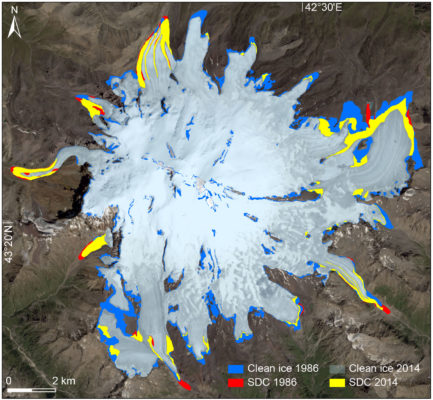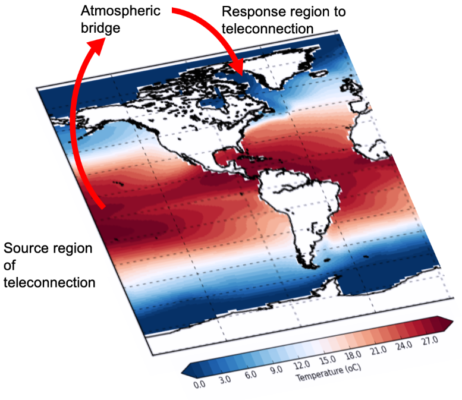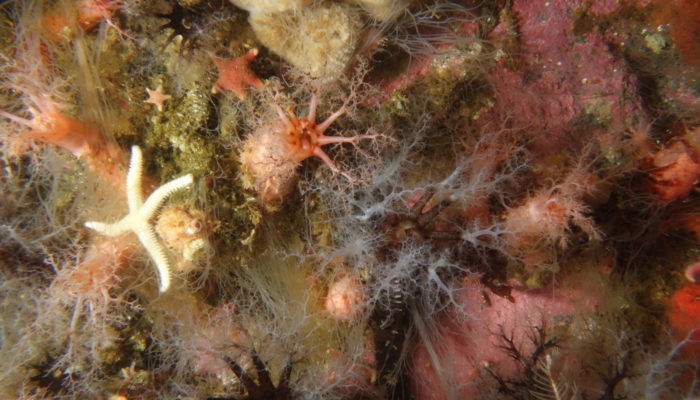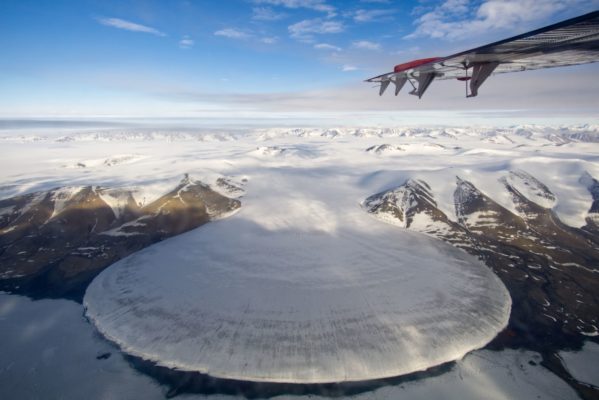Climate models help us understand processes occurring in and between atmosphere, oceans, land and ice-covered regions of our planet. One important process impacting all of us is sea level rise, and the ice sheets of Antarctica and Greenland (currently losing more and more ice) play a crucial role in future sea level rise projections. Even though climate models can be very complex and include many ...[Read More]
Does debris cover offset glacier retreat in the Greater Caucasus?

In this week’s blog, Levan Tielidze tells us about supra-glacial debris cover change for the Greater Caucasus. His recent study indicates more than a doubling in the area of supra-glacial debris cover for the Elbrus Massif‘s glaciers from 1986 to 2014, the largest glacierized massif in the whole region. Glaciers on the western slope of the Elbrus Massif are affected by avalanches and thus ar ...[Read More]
Life of a scientist: When fieldwork doesn’t go to plan…
Climate research questions tend to focus on the future. What will global temperature be in 2100? Will extreme weather events become more frequent? When will sea level rise render coastal homes uninhabitable? But our understanding of climate processes first comes from observing the past: palaeoclimatology. To get these records, scientists often go on fieldwork to collect samples. But what happens w ...[Read More]
Radiocarbon rocks! – How rocks can tell us about the history of an ice sheet…

When most people hear the phrase “radiocarbon dating”, they think of measuring carbon to date organic material. But did you know that carbon is also produced within rocks, and that we can use it to learn about the past behaviour of a glacier? About 20,000 years ago it was colder and large parts of the continents were covered by ice. But what did Antarctica – the largest ice mass ...[Read More]
What’s up on Thwaites Glacier?

With the West Antarctic Ice Sheet currently losing ice at a fast pace, leading to sea-level rise, it is very important to better understand the processes by which this ice melting occurs. In this context, Thwaites Glacier is a very good case study of an accelerating glacier, which contributes substantially to sea-level rise, and for which a huge scientific collaboration effort has recently been se ...[Read More]
Trapped in the sea ice – Educating the future generations of polar scientists
In October 2019, the research icebreaker ‘Polarstern’ was moored to an ice floe for its year-long journey through the Arctic Ocean. Come with us on a slightly shorter journey and learn how MOSAiC participants from the supporting cruise educate the future generation of polar scientists! What is the MOSAiC expedition? The MOSAiC (Multidisciplinary drifting Observatory for the Study of Arctic Climate ...[Read More]
Boom and bust beneath the ice
Beneath the frozen surface of the Southern Ocean, live some of the most spectacular creatures on earth. These creatures are spectacular not only in appearance, but also in their ability to survive in such an extreme environment as Antarctica. Here, temperatures deviate only slightly from 0°C, and food is scarce during the winter months. How do these diverse creatures live in these conditions and w ...[Read More]
The foot of a glaciated mammoth? No… A glacier!
Ice is a viscous fluid: it flows but slowly, reaching up to 100 m/yr for the fastest flowing ice. That’s 0.00001 km/hr, so you’d never see it with the naked eye. But what influences the morphology of the glaciers is the shape of the topography that lies underneath them. Elephant Foot Glacier, shown above, aptly named for its shape, is a textbook-example of a piedmont glacier. These types of glacie ...[Read More]
An interview with Jean Holloway on the importance of mental health in graduate school
Recent studies have shown that mental health conditions are far more common in graduate students than in the general public (e.g. Bolotnyy et al., 2020). Despite the prevalence, these issues are not something that are often openly discussed, and graduate students often don’t seek treatment. This week, we are interviewing Jean Holloway who aims to shed some light on her personal experience with som ...[Read More]
Climate Change & Cryosphere – The tropical fingerprint in Arctic climate

We know that climate change is being felt worldwide, but it is especially prominent in the Arctic, where temperatures are warming twice as fast as anywhere else on the planet. This especially sensitive environment, whose icy, snow-covered land and sea is so important in the global climate system, is really starting to feel the heat. But where is this heat coming from? In this blog post, we will ex ...[Read More]


